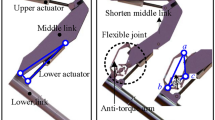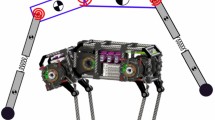Abstract
The lateral fall of a quadruped robot is difficult to avoid. However, there are few studies on the fall recovery of quadruped robots, especially that with large size and weight. One of the important reasons originates from the driving capability of robot joints. This paper analyzes the fall recovery behavior of several animals in nature, and designs a bionic shell structure. Then the working mechanism and critical conditions of the shell have been studied in detail. The shell that with the ability of regulating the energy changes of the robot when rolling, can make the quadruped robot withstand large impacts and avoid tipping. Based on the compliant movement generated by the arc-shaped contour of the bionic shell, the demand for the explosive joint driving force can be greatly reduced. These inherent advantages of the mechanism of the shell make it suitable for the lateral fall recovery of a large quadruped robot. The effectiveness of the mechanism is verified by simulation. Moreover, the performance of the bionic shell is discussed, for different factors including impacts, terrains and structures.
Access this chapter
Tax calculation will be finalised at checkout
Purchases are for personal use only
Similar content being viewed by others
References
Sugihara, T., Yamamoto, T.: Foot-guided agile control of a biped robot through ZMP manipulation. In: 2017 IEEE/RSJ International Conference on Intelligent Robots and Systems, Vancouver, pp. 4546–4551 (2017)
Poulakakis, I.: Spring loaded inverted pendulum embedding: extensions toward the control of compliant running robots. In: 2010 IEEE International Conference on Robotics and Automation, Anchorage, pp. 5219–5224 (2010)
Winkler, A., Havoutis, I., Bazeille, S., et al.: Path planning with force-based foothold adaptation and virtual model control for torque controlled quadruped robots. In: 2014 IEEE International Conference on Robotics and Automation, Hong Kong, pp. 6476–6482 (2014)
Dickinson, M.H., Farley, C.T., Full, R.J., et al.: How animals move: an integrative view. Science 288(5463), 100–106 (2000)
Raibert, M., Blankespoor, K., Nelson, G., et al.: BigDog, the rough-terrain quadruped robot. In: IFAC Proceedings, pp.10822–10825 (2008)
Yang, J., Jia, W., Sun, Y., et al.: Mechanical design of a compact and dexterous quadruped robot. In: 2017 IEEE International Conference on Mechatronics and Automation (ICMA 2017), Takamatsu, pp. 1450–1456 (2017)
Claudio, S., Jake, G., Bilal, R., et al.: Design overview of the hydraulic quadruped robots HyQ2Max and HyQ2Centaur. In: The Fourteenth Scandinavian International Conference on Fluid Power, Tampere, pp. 20–22 (2015)
Saranli, U., Alfred, A., Daniel, E.: Model-based dynamic self-righting maneuvers for a hexapedal robot. Int. J. Robot. Res. 23, 903–918 (2004)
Chen, K., Chen, D., Zhang, Z., et al.: Jumping robot with initial body posture adjustment and a self-righting mechanism. Int. J. Adv. Robot. Syst. 13, 127–135 (2016)
Noh, M., Kim, S.W., An, S., et al.: Flea-inspired catapult mechanism for miniature jumping robots. IEEE Trans. Rob. 28(5), 1007–1018 (2012)
Kashiri, N., Baccelliere, L., Muratore, L., et al.: CENTAURO: a hybrid locomotion and high power resilient manipulation platform. IEEE Robot. Autom. Lett. 4, 1595–1602 (2019)
Castano, J.A., Zhou, C., Tsagarakis, N.: Design a fall recovery strategy for a wheel-legged quadruped robot using stability feature space. In: 2019 IEEE International Conference on Robotics and Biomimetics (ROBIO 2019), Dali, pp. 41–46 (2019)
Kanehiro, F., Kaneko, K., Fujiwara, K., et al.: The first humanoid robot that has the same size as a human and that can lie down and get up. In: 2003 IEEE International Conference on Robotics and Automation (ICRA 2003), Taipei, pp. 1633–1639 (2003)
Stückler, J., Schwenk, J., Behnke, S.: Getting back on two feet: reliable standing-up routines for a humanoid robot. In: Proceedings of the 9th International Conference on Intelligent Autonomous Systems, Tokyo, pp. 676–685 (2006)
Ruhr, I.M., Rose, K.A.R., Sellers, W.I., et al.: Turning turtle: scaling relationships and self-righting ability in Chelydra serpentina. Proc. R. Soc. B 288(1946), 20210213 (2021)
Zhang, J., Li, J., Li, C., et al.: Self-righting physiology of the ladybird beetle Coccinella septempunctata on surfaces with variable roughness. J. Insect Physiol. 130, 104202–104211 (2021)
Peng, J., Song, G., Qiao, G., et al.: A self-recovery mechanism for quadrotors. In: 2014 IEEE International Conference on Robotics and Biomimetics, Bali, pp. 1531–1536 (2014)
Huang, Z., Jia, W., Sun, Y., et al.: Design and analysis of a transformable spherical robot for multi-mode locomotion. In: 2017 IEEE International Conference on Mechatronics and Automation, Takamatsu, pp. 1469–1473 (2017)
Nemoto, T., Mohan, R.E., Iwase, M.: Rolling locomotion control of a biologically inspired quadruped robot based on energy compensation. Robotics 1–10 (2015)
Xuan, Q., Li, C.: Coordinated appendages accumulate more energy to self-right on the ground. IEEE Robot. Autom. Lett. 5(4), 6137–6144 (2020)
Jung, G.P., Casarez, C.S., Baek, S.-M., et al.: JumpRoACH: a trajectory-adjustable integrated jumping-crawling robot. IEEE/ASME Trans. Mechatron. 24(3), 947–958 (2019)
Michael, K.: Meet Boston dynamics’ LS3 - the latest robotic war machine. Tedxuwollongong Talk 2012 (2012)
Niquille, S.C.: Regarding the pain of SpotMini: or what a robot’s struggle to learn reveals about the built environment. Archit. Des. 89(1), 84–91 (2019)
Author information
Authors and Affiliations
Corresponding author
Editor information
Editors and Affiliations
Rights and permissions
Copyright information
© 2021 Springer Nature Switzerland AG
About this paper
Cite this paper
Zeng, X. et al. (2021). Research on Passive Energy-Regulated Bionic Shell for Lateral Fall Recovery Behavior of Large Quadruped Robots. In: Liu, XJ., Nie, Z., Yu, J., Xie, F., Song, R. (eds) Intelligent Robotics and Applications. ICIRA 2021. Lecture Notes in Computer Science(), vol 13015. Springer, Cham. https://doi.org/10.1007/978-3-030-89134-3_23
Download citation
DOI: https://doi.org/10.1007/978-3-030-89134-3_23
Published:
Publisher Name: Springer, Cham
Print ISBN: 978-3-030-89133-6
Online ISBN: 978-3-030-89134-3
eBook Packages: Computer ScienceComputer Science (R0)




